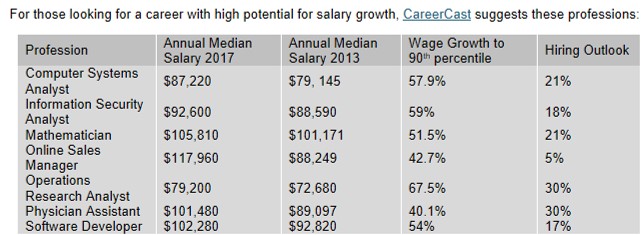The data on jobs, wage growth and employment can seem pretty confusing these days. Standard economic models work in theory but don’t always pan out in reality. Reading some of the latest news on the employment scene can give you whiplash.
Jobs with Fast-Growing Salaries
 A recent report from CareerCast listed the jobs with the potential for fast-growing salaries but also noted that high-starting salaries don’t always deliver over time.
A recent report from CareerCast listed the jobs with the potential for fast-growing salaries but also noted that high-starting salaries don’t always deliver over time.
“High salary growth rate and overall highest paying jobs are not necessarily one in (sic) the same,” said Kyle Kensing, CareerCast’s Online Content Editor. He pointed out that careers with high entry-level salaries may not grow much from the median to the upper wage levels. “Similarly, some high-paying jobs did not grow as much in median pay since the 2013 Jobs Rated Report.”
This survey indirectly reinforces STEM education as a gateway to lucrative careers. Here is CareerCast’s list of jobs with fast-growing salaries in alphabetical order by title. Five of them fall into STEM categories.
States with the Most Robots
On the other hand, if you want to avoid losing your job to a robot, stay out of Michigan and 19 other states.
A Brookings Institution report issued in August listed the states with the most industrial robots as a percentage of workers and Michigan came out on top. The report notes that industrial robots are, “highly concentrated in the Midwest and upper South.” This finding comes as no surprise because the automotive industry employs 50% of industrial robots and these two areas have a high number of manufacturers of and for the automotive industry.
The report lists the number of industrial robots overall as well as the rate of industrial robots per worker:
The report’s authors note that the industrial robots cluster in what are predominantly red states that voted for Donald Trump. “As of 2015, there were 2.5 robots per 1,000 workers in red states, compared to just 1.1 robots per 1,000 workers in blue states.” The loss of jobs to automation may account for much of the dissatisfaction and the demand for change that caused many people to vote for the man who promised to bring back jobs.
Scapegoating immigrants in general, and Mexicans in particular, will not stop the transfer of jobs from human beings to industrial robots, however. And, as I noted before, the decisions to automate, outsource, or offshore jobs are generally made by white American men.
Last month, GE announced a series of layoffs that will have an impact on these states:
- GE Transportation: 825 jobs in Pennsylvania and Texas
- GE Power: 350 jobs in Waukesha, Illinois
- GE Lighting: 281 jobs in Ohio and Illinois
- GE Global Research; 150 jobs in Niskayuna, New York
- GE Aviation: 150 jobs in Michigan and Florida
Wage Growth Sends Mixed Signals
Despite ongoing automation and their attendant layoffs, the economy continues growing. The impact on wage growth appears to be mixed, however. In his Daily Shot newsletter, Lev Grossman reports that we are “Still Waiting for Those Wage Pressures to Materialize” and that “US real wage growth had declined last month, in part due to higher gasoline prices.”
Justin Lahart in The Wall Street Journal notes that while the labor market is strong, jobs growth is slowing. In his article “The Jobs Market at a Tipping Point,” he adds that,
“Some of that shift lower in hiring is a reflection of slow economic growth—companies aren’t going to hire to meet demand that isn’t there—so maybe if the recent pickup in gross domestic product continues, the job gains will reaccelerate. But it is also a reflection of a tighter labor market, where companies are struggling to fill jobs and are resisting paying higher wages to attract the workers they say they need. Average hourly earnings were up just 2.4% last month from a year earlier.”
Seasonal Hiring Trends
 The unemployment rate has dropped to 4.2% and the U.S. Labor Department reports 6.1 million unfilled jobs. That has stalled seasonal hiring for the Christmas rush. Hiring firm Monster reports that:
The unemployment rate has dropped to 4.2% and the U.S. Labor Department reports 6.1 million unfilled jobs. That has stalled seasonal hiring for the Christmas rush. Hiring firm Monster reports that:
“. . . , hiring for 2017 seasonal jobs is already seeing a 3.8% year-over-year increase from 2016, with 75,255 job ads for seasonal positions in September. That number is only expected to grow, as hiring for holiday jobs typically increases month-over-month in October, with 81,392 lob listings for seasonal employment posted last year.”
Some companies, like UPS and Toys R Us have raised wages or added weekly bonuses to make their jobs more attractive. As the CareerCast report highlights, however, not all jobs are equal. Some start high but don’t grow, some start low and grow fast, and others start low and never grow at all. Holiday jobs go away in January.
A manufacturing worker who loses a solid job that supports a family will not make the same wage with one or even two retail positions. Workers who have patched together multiple hourly wage positions don’t have the flexibility to add hours at any one of them and still bring home the same paycheck.
And yet, the Labor Department tells us that the number of workers seeking full-time jobs has dropped by nearly 250,000 people in the last year. Go figure.
If you’re trying to make sense of all this, I suggest taking advice usually applied to the New England weather: If you don’t like it, wait a minute. It will change.



So let me make sure I understand something David. From what I’ve read, you’re against the continued development of robotics, automation and AI, fearing the masses will rise up and create havoc over this. Yet you work for a robotics company today that promotes all three of these things in their products? Is that right?
Gotta make a living until the economy collapses.
There’s No You in AI
http://www.nationalreview.com/corner/453192/automation-theres-no-you-ai
Quote: “This is not going to end well.”
I find it ironic that so many of the high-tech companies have executives that, per a New Yorker piece, are afraid of “the masses” rising up as AI / automation displace people in large numbers – the point where many are buying remote (even fortified) properties, “survival bunkers”, or land overseas to which they plan to flee. And yet they persist.
Doomsday Prep for the Super-Rich
https://www.newyorker.com/magazine/2017/01/30/doomsday-prep-for-the-super-rich
** Quote:
I asked Hoffman to estimate what share of fellow Silicon Valley billionaires have acquired some level of “apocalypse insurance,” in the form of a hideaway in the U.S. or abroad. “I would guess fifty-plus per cent,” he said, “but that’s parallel with the decision to buy a vacation home. Human motivation is complex, and I think people can say, ‘I now have a safety blanket for this thing that scares me.’ ” The fears vary, but many worry that, as artificial intelligence takes away a growing share of jobs, there will be a backlash against Silicon Valley, America’s second-highest concentration of wealth. (Southwestern Connecticut is first.) “I’ve heard this theme from a bunch of people,” Hoffman said. “Is the country going to turn against the wealthy? Is it going to turn against technological innovation? Is it going to turn into civil disorder?”
It’s a “Basic Fact” of human nature that you cannot take away what people have – e.g., a stable job, a predictable future, an income that is solid enough to sustain you (and a family) – and replace it with something less stable, less predictable, and lower wage and expect people to be happy about it. And it bespeaks an INCREDIBLE level of cluelessness to then turn around and, as so many in the C-suite and consultant class do, lecture people about how “the surveys” say that people really do want the “freedom” and other pap of the gig economy.
It’s all propaganda to distract everyone from what they’re really doing.
It’s called “gaslighting”.